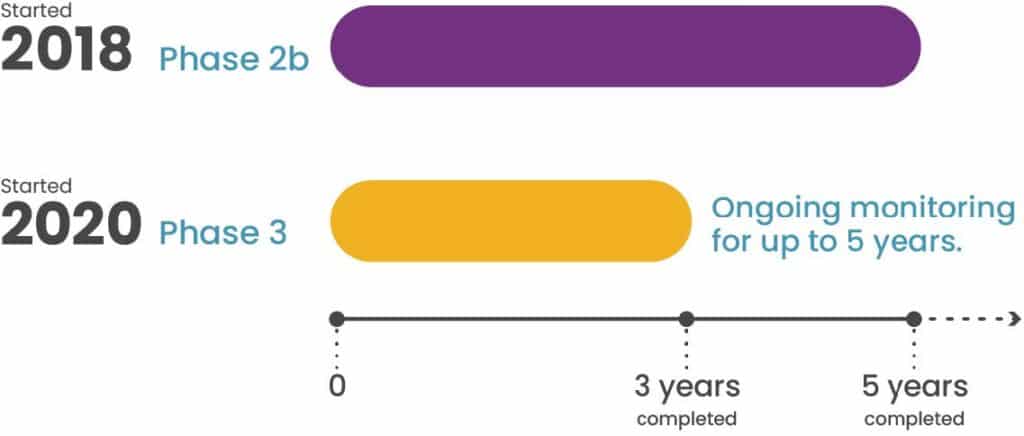This is a paid public announcement from CSL Behring and does not constitute an endorsement of products or services. When you click on the links in this blog entry, you will be directed to the CSL Behring website. LA Kelley Communications always advises you to be a savvy consumer when contacting any company; do not reveal identifying information against your will
Ongoing studies offer years of durability data
The clinical trials for HEMGENIX—the first-ever gene therapy for hemophilia B approved by the FDA—are set up so that those who have received HEMGENIX are monitored on an ongoing basis. Data has been published annually and have supported the consistent safety and efficacy of HEMGENIX. Studies for HEMGENIX began in 2018 with a phase 2b trial of 3 people with 5 years of data collected. The HOPE-B phase 3 trial began in 2020 with 54 people to evaluate the safety and efficacy of treatment. The FDA approved the treatment in 2022. HEMGENIX has been studied for over 5 years, with data continuing to be collected.
Clinical Trial Durations

In December 2023, CSL Behring released the three-year results from the phase 3 trial for HEMGENIX. In the ongoing HOPE-B study, results at 3 years confirmed the durability and safety of treatment with HEMGENIX following a one-time infusion in people living with hemophilia B, and will be studied up to 5 years.
HEMGENIX—a groundbreaking option
According to Dr. Steven Pipe, Professor of Pediatrics and Pathology at the University of Michigan and principal investigator of the HOPE-B pivotal trial:
“The long-term follow-up data from the HOPE-B study reinforces that a one-time treatment with HEMGENIX can produce elevated and sustained factor IX levels and reduce the rate of annual bleeds for years in people living with hemophilia B. Most importantly, the data show that nearly all the Phase III trial participants three years post-treatment with HEMGENIX have remained free from the need for regular prophylactic infusions, which is groundbreaking for the hemophilia B community.”
Are you ready for bleed protection that lasts for years instead of weeks? Talk to your doctor about the first-ever treatment option that offers your body the ability to make its own factor IX, and whose durability and safety has been confirmed for years.
IMPORTANT SAFETY INFORMATION
What is HEMGENIX?
HEMGENIX®, etranacogene dezaparvovec-drlb, is a one-time gene therapy for the treatment of
adults with hemophilia B who:
-
- Currently use Factor IX prophylaxis therapy, or
-
- Have current or historical life-threatening bleeding, or
-
- Have repeated, serious spontaneous bleeding episodes.
HEMGENIX is administered as a single intravenous infusion and can be administered only once.
What medical testing can I expect to be given before and after administration of HEMGENIX?
To determine your eligibility to receive HEMGENIX, you will be tested for Factor IX inhibitors. If this test result is positive, a retest will be performed 2 weeks later. If both tests are positive for Factor IX inhibitors, your doctor will not administer HEMGENIX to you. If, after administration of HEMGENIX, increased Factor IX activity is not achieved, or bleeding is not controlled, a post-dose test for Factor IX inhibitors will be performed.
HEMGENIX may lead to elevations of liver enzymes in the blood; therefore, ultrasound and other testing will be performed to check on liver health before HEMGENIX can be administered. Following administration of HEMGENIX, your doctor will monitor your liver enzyme levels weekly for at least 3 months. If you have preexisting risk factors for liver cancer, regular liver health testing will continue for 5 years post-administration. Treatment for elevated liver enzymes could include corticosteroids.
What were the most common side effects of HEMGENIX in clinical trials?
In clinical trials for HEMGENIX, the most common side effects reported in more than 5% of patients were liver enzyme elevations, headache, elevated levels of a certain blood enzyme, flu-like symptoms, infusion-related reactions, fatigue, nausea, and feeling unwell. These are not the only side effects possible. Tell your healthcare provider about any side effect you may experience.
What should I watch for during infusion with HEMGENIX?
Your doctor will monitor you for infusion-related reactions during administration of HEMGENIX, as well as for at least 3 hours after the infusion is complete. Symptoms may include chest lightness, headaches, abdominal pain, lightheadedness, flu-like symptoms, shivering, flushing, rash, and elevated blood pressure. If an infusion-related reaction occurs, the doctor may slow or stop the HEMGENIX infusion, resuming at a lower infusion rate once symptoms resolve.
What should I avoid after receiving HEMGENIX?
Small amounts of HEMGENIX may be present in your blood, semen, and other excreted/secreted materials, and it is not known how long this continues. You should not donate blood, organs, tissues, or cells for transplantation after receiving HEMGENIX.
Please see full prescribing information for HEMGENIX.
You are encouraged to report negative side effects of prescription drugs to the FDA. Visit www.fda.gov/medwatch, or call 1-800-FDA-1088.
You can also report side effects to CSL Behring’s Pharmacovigilance Department at 1-866-915-6958.
HEMGENIX is manufactured by uniQure Inc. and distributed by CSL Behring LLC.
HEMGENIX® is a registered trademark of CSL Behring LLC.
©2024 CSL Behring LLC 1020 First Avenue, PO Box 61501, King of Prussia, PA 19406-0901 USA
www.CSLBehring.com USA-HGX-0611-FEB24

